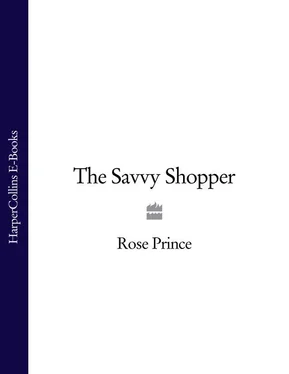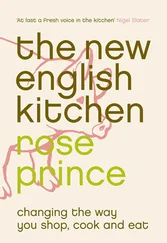The Savvy Shopper
All You Need to Know About the Food you Buy
Rose Prince

For Jack and Lara
Cover Page
Title Page The Savvy Shopper All You Need to Know About the Food you Buy Rose Prince
INTRODUCTION INTRODUCTION The Savvy Shopper column first appeared in the Daily Telegraph’s Weekend section in October 2004. Its aim was to provide a guide not only to feeling good about the food we buy, but to also help find the food that gives the most sensory pleasure – that rare thing, a guiltfree shopping trip. The philosophy was rooted in ethical shopping, and the timing for the first column was perfect. Words and phrases like ‘organic’, ‘Fairtrade’, ‘welfare-friendly’ and ‘food miles’ were on our consciences, but there was no existing detailed guide tying food issues to a shopping directory. The first Savvy Shopper article featured apples and must have touched a nerve. The letters began to pour in – concerned, intrigued, frustrated and curious. It was obvious that there is an army of discerning food shoppers in this country whose quest is to buy food with peace of mind and a clear conscience but also to enjoy great flavours, aromas and textures. A year and a half later, the column has developed a huge and enthusiastic following and, as so many correspondents admitted to cutting out and keeping the page, it seemed crazy not to collect it all into a book, expanding, updating and adding new suppliers and foods. Shoppers need an at-a-glance guidebook to chuck into the car, bag or pushchair when setting out to shop. And since many of the listed suppliers are also able to offer home delivery, it’s one to keep by the telephone or laptop, too. But savvy shopping doesn’t just begin and end in your own kitchen – it has a wider influence, too. The food industry (the producers, manufacturers and retailers) has one objective: to please you. Over the eighteen months since the Savvy Shopper was born, the food industry’s bigger businesses have made some remarkable policy changes. One supermarket chain has pledged to source fish more responsibly, another has promised to remove (most) artificial additives from its ready meal range and a potato crisp giant has promised to fry in ‘healthier’ oil. As I write, mission statements are popping up all over the place. Media exposure has a great impact on food issues, it’s true, but the greatest impact on the food industry will come from us – the willing shoppers who want, and increasingly demand, to eat excellent, ethically produced food that tastes good.
FOOD’S BIG ISSUES FOOD’S BIG ISSUES Food’s big issues (what on earth do they mean?) Food miles, genetic modification, pesticide residues, vCJD, GM terminator seeds, hydrogenated fats, interesterification, transfats, stalls and tethers, specified risk material, formed meats, cheese food, modified maize starch, hormone disruptors, irradiation, mechanically recovered meats, broiler houses, batteries, FADS, aquaculture, nature identical flavourings, stabilisers, emulsifiers and over 40 colourings, many of them artificial… A warm welcome to the food industry, and all the wiles and ways it employs to reap the most at the least cost. The words above have a connection to your kitchen. You probably bought something today that relates to at least one of them. We hear phrases like GM and food miles bandied about, but what do they really mean?
HOW TO SHOP FOR BRITISH FOOD IN SEASON HOW TO SHOP FOR BRITISH FOOD IN SEASON UK-grown vegetables and fruit New breeds, modern storage and the wider (and controversial) use of polytunnels and glasshouses mean that the season for UK-grown produce is now greatly extended. British tomatoes, for example, are available from February onwards. Supermarkets sometimes stock UK produce in preference to imports (e.g. apples, strawberries and raspberries) but unless they can buy in large quantities throughout the whole UK season for a particular vegetable or fruit, they tend to source imports, which are often cheaper. For this reason there is more chance of buying a wider variety of UK-grown produce through ‘box schemes’, which are more economical if bought direct from the farm where they are grown. Best value is to be had during the ‘glut’ – the natural window when outdoor-grown produce peaks and is at its most abundant.
SEASONAL CHART
APPLES
ASPARAGUS
BABY FOOD AND INFANT FORMULA
BACON (AND PORK)
BANANAS
BEEF
BISCUITS
BREAD
BREAKFAST CEREAL
BROCCOLI (AND OTHER BRASSICAS)
BURGERS
BUTTER AND SPREADS
CANNED VEGETABLES AND FRUIT
CHEDDAR CHEESE
CHERRIES
CHICKEN (AND OTHER POULTRY)
CHOCOLATE
COD
COFFEE
CRAB AND LOBSTER
CREAM
CURED PORK
DRESSINGS
DRIED FRUIT
EGGS
FLOUR
FRENCH BEANS (AND OTHER FRESH BEANS)
FRUIT JUICE
HERBS
HONEY
ICE CREAM
LAMB
LARD AND DRIPPING
LETTUCE AND SALAD LEAVES
LONG GRAIN RICE
LUNCHBOX FOODS
MAYONNAISE
MILK
MUSTARD
NOODLES
NUTS
OLIVE OIL
ORANGES (AND OTHER CITRUS FRUIT)
OYSTERS, MUSSELS, SCALLOPS (AND OTHER BIVALVES)
PASTA
PEAS
PHEASANT (AND OTHER GAME)
PORK PIES
POTATO CRISPS
POTATOES AND OVEN CHIPS
PRAWNS
PULSES
READY MEALS
RISOTTO RICE
SALMON
SALT
SAUSAGES
SOFT DRINKS
SOY SAUCE
SPICES
STOCK
STRAWBERRIES
SUGAR
SUSHI
TEA
TOFU
TOMATO KETCHUP
TOMATOES
TROUT
TUNA
TURKEY (AND GOOSE)
VEGETABLE OILS
WATER (BOTTLED)
YOGHURT
Acknowledgements
About the Author
Also by Rose Prince
Copyright
About the Publisher
The Savvy Shopper column first appeared in the Daily Telegraph’s Weekend section in October 2004. Its aim was to provide a guide not only to feeling good about the food we buy, but to also help find the food that gives the most sensory pleasure – that rare thing, a guiltfree shopping trip. The philosophy was rooted in ethical shopping, and the timing for the first column was perfect. Words and phrases like ‘organic’, ‘Fairtrade’, ‘welfare-friendly’ and ‘food miles’ were on our consciences, but there was no existing detailed guide tying food issues to a shopping directory.
The first Savvy Shopper article featured apples and must have touched a nerve. The letters began to pour in – concerned, intrigued, frustrated and curious. It was obvious that there is an army of discerning food shoppers in this country whose quest is to buy food with peace of mind and a clear conscience but also to enjoy great flavours, aromas and textures. A year and a half later, the column has developed a huge and enthusiastic following and, as so many correspondents admitted to cutting out and keeping the page, it seemed crazy not to collect it all into a book, expanding, updating and adding new suppliers and foods. Shoppers need an at-a-glance guidebook to chuck into the car, bag or pushchair when setting out to shop. And since many of the listed suppliers are also able to offer home delivery, it’s one to keep by the telephone or laptop, too.
But savvy shopping doesn’t just begin and end in your own kitchen – it has a wider influence, too. The food industry (the producers, manufacturers and retailers) has one objective: to please you. Over the eighteen months since the Savvy Shopper was born, the food industry’s bigger businesses have made some remarkable policy changes. One supermarket chain has pledged to source fish more responsibly, another has promised to remove (most) artificial additives from its ready meal range and a potato crisp giant has promised to fry in ‘healthier’ oil. As I write, mission statements are popping up all over the place. Media exposure has a great impact on food issues, it’s true, but the greatest impact on the food industry will come from us – the willing shoppers who want, and increasingly demand, to eat excellent, ethically produced food that tastes good.
Читать дальше













